Drive sustainability transformation faster with new data and AI capabilities
This month, we’re thrilled to announce new data solutions and generative AI advancements in Microsoft Cloud for Sustainability and Microsoft Fabric, providing new levels of speed and efficiency in processing data to help you drive faster progress toward sustainability goals. Read how to get actionable insights from your data using sustainability data solutions in Microsoft Fabric and natural language queries with Copilot in Microsoft Sustainability Manager, and about other AI-powered features now available in preview.
Gather and analyze all your ESG data in one place with Microsoft Fabric
sustainability data solutions in microsoft fabric
With sustainability data solutions in Microsoft Fabric (preview), you can analyze your organization’s environmental, social, and governance (ESG) data together with your other enterprise data to inform more holistic decisions and better-targeted outcomes. Gather, harmonize, and transform sustainability data into meaningful, actionable insights, and use advanced analytics and powerful AI to help you prepare data for analysis, regulatory reporting, and AI-driven innovation.

Microsoft Cloud for Sustainability
Empowering organizations to accelerate sustainability progress and business growth
You can also use sustainability data solutions in Fabric to validate your data and track progress against publicly available data and industry benchmarks. All this comes with a shared governance model across various capabilities and a unified space for your data stewards and sustainability practitioners to interact through Microsoft Fabric.
Four solution capabilities help you holistically meet your sustainability requirements:
- ESG data estate (preview) helps you centralize and standardize ESG data from your disparate data sources to compute, analyze, and disclose ESG metrics for various regulatory reporting and analytics requirements.
- Microsoft Azure emissions insights (preview) enable you to report and analyze your Microsoft Azure usage–related emissions data at subscription and resource levels.
- Environmental metrics and analytics (preview) help you generate custom reports, metrics, and analytics insights across carbon, water, and waste by connecting to your data in Microsoft Sustainability Manager.
- Social and governance metrics and reports (preview) provide insights, dashboards, and metrics to support your needs across various sustainability directives.
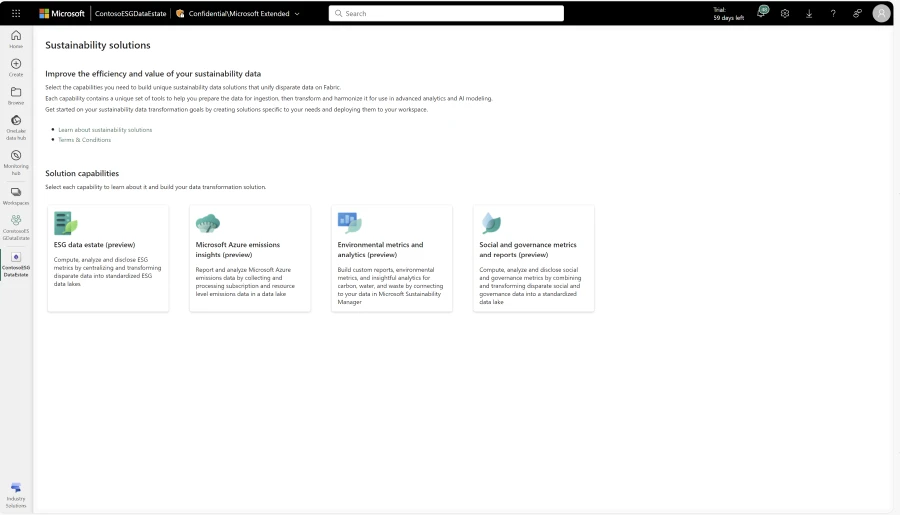
Build your ESG data estate (preview)
Sustainability disclosures, analytics, and reduction initiatives require rich ESG data sets that originate from disparate sources, and this data needs to be unified and standardized to improve its efficiency and value. sustainability data solutions in Microsoft Fabric (preview) provides pre-built data pipelines and lakehouses to combine social and governance data from different enterprise systems with environmental data from Microsoft Sustainability Manager and other systems.
With your ESG data estate in place, you can process unified sustainability data to compute ESG metrics for sustainability disclosure requirements such as Corporate Sustainability Reporting Directive (CSRD), Global Reporting Innitiative (GRI), and many others using provided prebuilt data processing artifacts. You can run this process on demand or on a schedule.
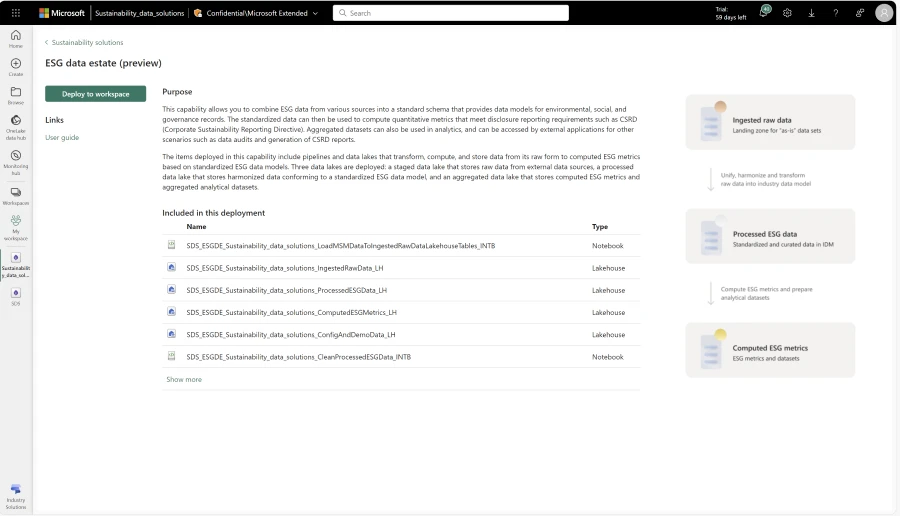
Built-in dashboards let you view data and insights from a variety of perspectives—such as by facility or operating unit—and use workflows to help prepare reports. You can mark the metrics required for CSRD and other disclosures and prepare the reports to share with auditors.
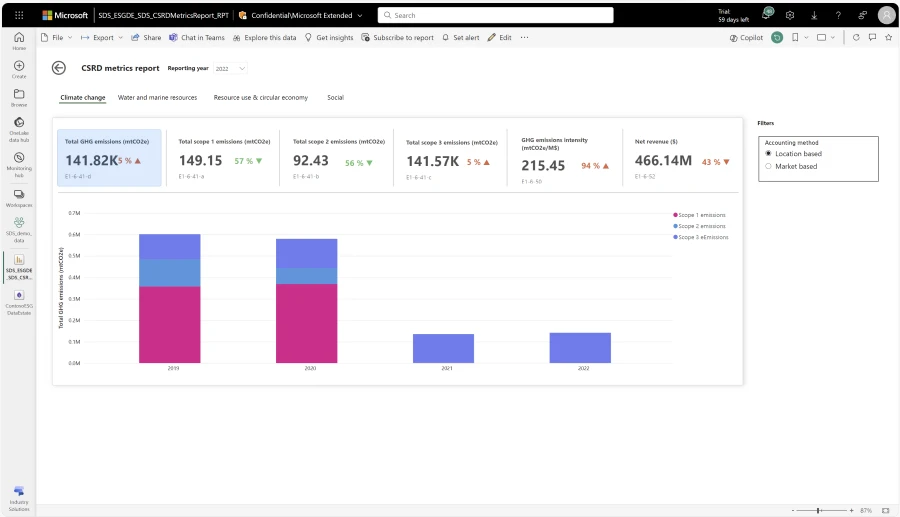
Gain detailed Microsoft Azure emissions insights (preview)
The typical IT efficiency journey for many organizations starts with migrating and then optimizing workloads in the cloud, which involves factoring potential emissions reduction strategies. Microsoft Fabric facilitates this process by enabling you to unify and analyze your Azure emissions data against your cloud usage.
With all your Azure emissions data in Microsoft Fabric, you can query and drill down into Azure resource-level emissions for advanced reporting and analysis. Use pre-built data pipelines that ingest and store resource-level Azure emissions data in tabular data. And use Power BI dashboards to drill down and compare emissions data across subscriptions and resources, helping to identify patterns that evolve with time and usage.
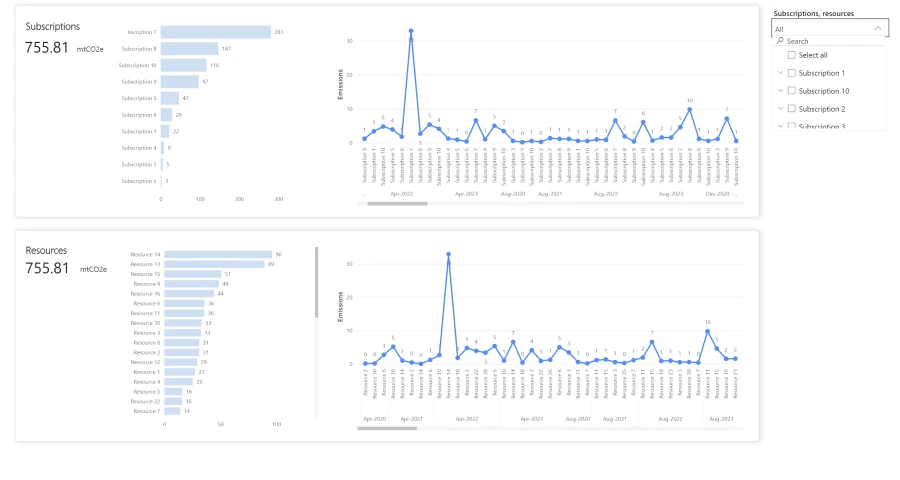
Note that all Azure customers can now easily access data and insights related to their cloud usage-based emissions by simply signing into the Azure portal and navigating to Azure carbon optimization (preview). This feature provides an overview of your subscription’s emissions data for the past 12 months and by service type—such as virtual machines or storage.
On the Emissions Details page, you’ll see a monthly breakdown of the top Azure resources that contribute to your organization’s total emissions. By comparing this data to the previous month, you can see the percentage change and identify resources to turn off or utilize more efficiently. On the Emissions Reductions page, you’ll find recommendations to improve your organization’s cloud efficiency and sustainability.
Enrich your understanding of environmental metrics and analytics (preview)
To better understand your progress on reduction and other initiatives across carbon, water, and waste, you may need to define and compute custom metrics. Microsoft Fabric lets you connect to your relevant data in Microsoft Sustainability Manager and provides tables to query, compute custom metrics, and analyze the data further. You can enrich your sustainability data with the other corporate and business data for advanced machine learning–based analytics and leverage prebuilt Power BI dashboards for detailed insights and visualizations.
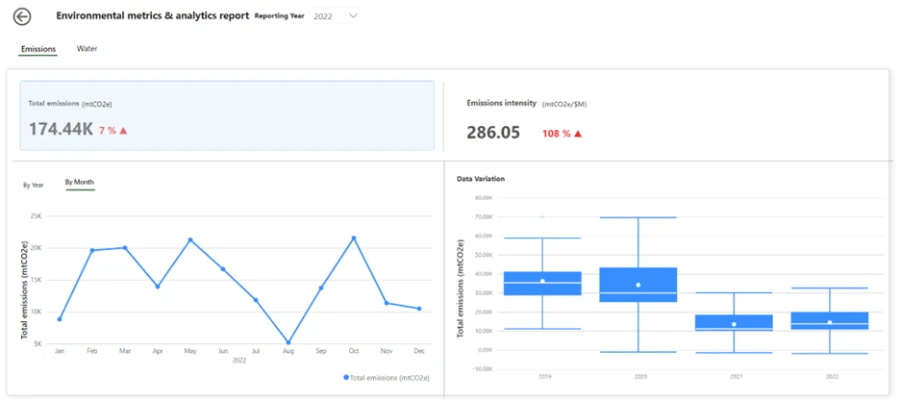
Analyze your social and governance metrics and reports (preview)
Increasingly, organizations are required to disclose their sustainability performance in social and governance areas—for example, for CSRD. To address this need, Microsoft Fabric enables you to unify and prepare disparate data from corporate systems handling human resources, health and safety, and corporate governance data in a single ESG data estate. From there, you can compute and report social and governance metrics required for disclosures and use Power BI dashboards to visualize and drill down into selected areas.
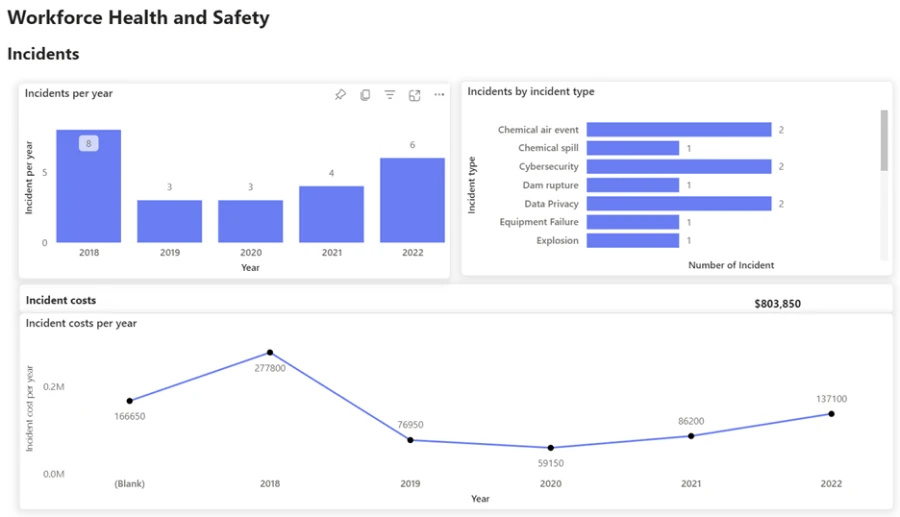
Introducing Copilot in Microsoft Sustainability Manager: Quickly turn your sustainability data questions into insights
When you’re working with disparate ESG data from across your operations and value chains, getting answers to critical questions quickly can be challenging, potentially slowing down progress toward sustainability goals. Copilot in Microsoft Sustainability Manager, now in preview, immediately delivers insights from your data based on natural language queries.
get ready for esg reporting with increased data transparency
Ask Copilot a question and it will work across Microsoft Sustainability Manager to quickly understand environmental data and provide an answer. For example, you can ask Copilot the right global warming potential (GWP) value for a given gas and assessment report (AR) version. With Copilot’s assistance, you can more confidently work through tasks like drafting reports on your organization’s emissions or CSRD environmental metrics for a quarterly update. Copilot helps you generate the draft reports, reducing your preparation time.

Copilot can also help simplify and accelerate complex processes within Microsoft Sustainability Manager, such as creating a calculation model for your mobile combustion data. Within seconds, a calculation model is created using natural language, and within minutes these emissions are calculated, providing a more complete picture of reduction opportunities.
Copilot in Microsoft Sustainability Manager is trained on Microsoft Cloud for Sustainability data schemas, making it an effective and knowledgeable tool for improving efficiency across various tasks.
Magnify your visibility into your ESG data with AI-powered insights
Intelligent insights
It’s important to trust the accuracy of your organization’s ESG data, which can be large and complex. The faster you can identify errors or missing data, the faster you can resolve or fill in the data. Intelligent insights in Microsoft Sustainability Manager, now available in preview, provides the visibility into your ESG data needed to help identify outliers, trends, and correlations.
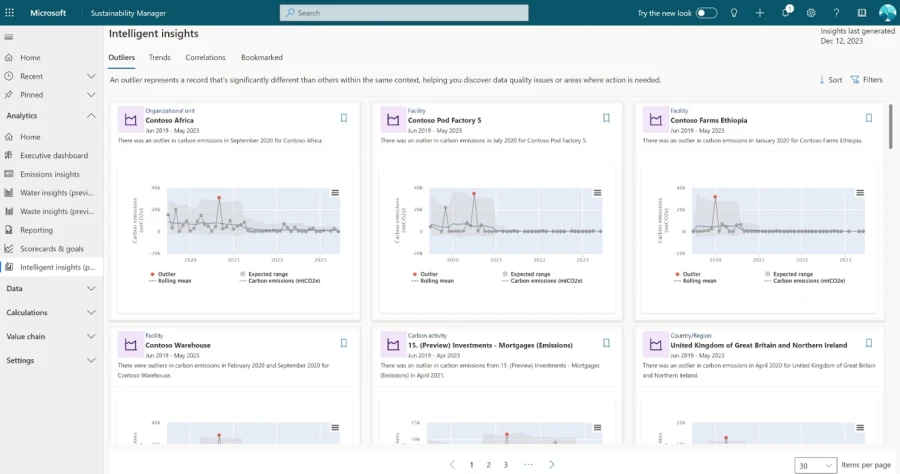
See where data needs cleaning or where you need more complete data. This feature scans your organization’s data within Microsoft Sustainability Manager and identifies opportunities—both short-term and long-term—for reductions that align to your sustainability initiatives. Insights are based on historical trends, seasonality, and data anomalies. Looking deeper into the results, you can identify opportunities for reduction in your organization’s Scope 3 emissions.
Learn more about how intelligent insights can help you make sense of an increasingly complex data landscape.
Now generally available in Microsoft Sustainability Manager
Track, manage, and report your water and waste sustainability data
In addition to expanding AI capabilities, we’re continuing to evolve Microsoft Sustainability Manager to meet broader environmental sustainability objectives. Along with carbon emissions data capabilities, water and waste sustainability data capabilities are now generally available.
Organizations can track and report their water accounting, water usage efficiency, and compliant water discharges across multiple facilities, safe water discharge regulations, and water usage disclosure standards. Microsoft Sustainability Manager helps you understand the sources and quantities of waste generation at your facilities and how the waste gets disposed of. This can further help you discover avenues to increase waste recycling for specific waste sources and reduce off-site waste disposal through landfills and incineration.
Simplify supplier data collection with ESG value chain solution
new ways to improve your circularity data with microsoft sustainability manager
We’re excited to announce the general availability of ESG value chain solution in Microsoft Sustainability Manager, enabling you to gather data more directly and securely from your suppliers. You can use the data to calculate suppliers’ emissions and gather partner-specific emission factors to calculate your Scope 3 emissions based on your consumption with those partners.
Experience the new capabilities in action with This is AI…for Sustainability
Hear from Melanie Nakagawa, Chief Sustainability Officer, Shelly Blackburn, Global Vice President for Sustainability Go to Market, and Satish Thomas, Corporate Vice President, Microsoft Industry Clouds during this free digital event. Get guidance on your sustainability journey and learn how to drive business transformation with Microsoft data and AI solutions. Watch the webcast on demand.
Learn more about sustainability solutions with Microsoft
- Want to learn more about Microsoft Cloud for Sustainability? Sign up for news and updates and try it for free.
- Discover solutions with Microsoft Sustainability Manager.
The post Drive sustainability transformation faster with new data and AI capabilities appeared first on Microsoft Industry Blogs.
Source: Microsoft Industry Blog
